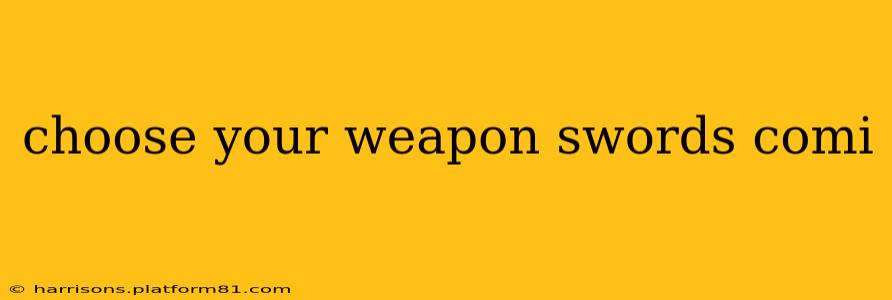Choosing Your Weapon: A Deep Dive into the World of Swords in Comics
The world of comics is brimming with iconic weaponry, but few are as timeless and visually striking as the sword. From the gleaming blades of Arthurian legends to the futuristic katanas of cyberpunk dystopias, swords hold a special place in the hearts of comic book readers and creators alike. Choosing the "right" sword depends heavily on the character wielding it and the narrative context, so let's explore the diverse arsenal available in the comic book universe.
What are the different types of swords used in comics?
Comic book swords are as diverse as the characters who wield them. We see everything from the classic longsword, favored for its versatility in battle, to the more specialized rapiers, known for their finesse and speed. Broadswords, with their wider blades ideal for slashing attacks, also make frequent appearances. Then there are the more exotic options: the curved scimitar, the double-edged katana, and even fantasy-inspired blades imbued with magical properties. The choice often reflects the character's fighting style and cultural background. A samurai might wield a katana, while a knight errant might prefer a longsword or claymore.
What makes a sword a good weapon in a comic book context?
Beyond the obvious visual appeal, a sword's effectiveness in a comic book context depends on several factors. Its design must align with the character's personality and fighting style. A brooding, powerful hero might wield a large, imposing greatsword, while a nimble rogue might prefer a lighter, quicker blade. The narrative purpose also plays a key role. Is the sword a family heirloom, a symbol of power, or a magically enchanted artifact? These details enrich the weapon's significance within the story. The visual representation is crucial too – the artist's depiction of the sword's design, its gleam, and the way it moves during combat greatly impacts its perceived power.
How are swords depicted differently across various comic book genres?
The portrayal of swords varies significantly across different comic book genres. In fantasy comics, swords often possess magical properties, acting as keys to hidden realms or sources of immense power. In superhero comics, swords might be technologically advanced, perhaps forged from extraterrestrial materials or imbued with energy-based abilities. Sci-fi comics might feature futuristic, laser-based swords or energy blades, while historical comics would showcase the accurate depiction of swords from specific historical periods. The genre heavily influences the design, function, and symbolic meaning of the sword.
What are some iconic swords from famous comic books?
Numerous iconic swords have emerged from the pages of comic books. Excalibur, the legendary sword of King Arthur, is perhaps the most famous example, symbolizing power, righteousness, and destiny. The Muramasa swords in various manga and anime adaptations frequently feature in comic-inspired narratives, often carrying a dark and ominous aura. Many superhero comics feature unique sword designs tailored to their characters, further solidifying the weapon's importance to its wielder.
Are there any real-world sword types that inspire comic book designs?
Many comic book sword designs draw inspiration from real-world counterparts. Artists often reference historical European swords, Japanese katana, or even ancient Celtic weaponry. This blend of historical accuracy and artistic license helps create unique and believable weapons that resonate with readers familiar with real-world swordsmithing traditions. However, comic book creators frequently take liberties, blending historical designs with fantastical elements to achieve their desired aesthetic.
In conclusion, the sword in comics is more than just a weapon; it's a powerful symbol, a storytelling tool, and a visual spectacle. Its versatility allows for diverse interpretations across genres, enriching the narratives and characters it graces. The careful choice of sword type, design, and narrative significance ultimately elevates the comic book experience.
